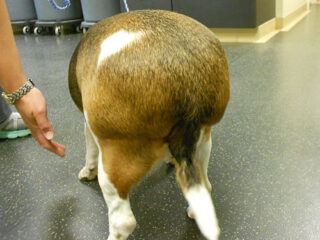As few as five pounds above your dog’s ideal weight could put it at risk for serious medical conditions. When a dog is overweight or obese it no longer is a question of “if” your dog will develop a condition but “when”. Some of the common disorders developing with excess weight include:
- Diabetes
- Respiratory and Heart disease
- Osteoarthritis
- High blood pressure
- Many forms of cancer – especially intra-abdominal cancers

Overweight and obese dogs are expected to live shorter lives, physically interact less with their families and they are less energetic and playful. Illnesses are easily overlooked, since the lethargy is interpreted as lazyness.
The Purina Lifespan Study proved that maintaining dogs in lean body condition extended their life span by nearly 2 years. To read more about the study click here.
We had great results with a Beagle who was surrendered to us: by feeding smaller portions of healthy food and taking her on brisk walks she lost 14 pounds in only a few months. She was monitored to make sure she stayed healthy while losing weight. Read Phoebe’s story by clicking on this link.
Food
First check with Dr. Neumeister, because a dog should not be on a diet unless a possible medical condition is ruled out first. For example, some common diseases associated with weight gain include hypothyroidism and hyperadrenocorticism or Cushing’s disease.
If Dr. Neumeister evaluates the dog as healthy she may ask you to transition to a different diet and to start offering small portions of food several times per day. She will determine the best type of food for every dog individually. She might recommend select commercial pet foods that are formulated to provide adequate nutrients. Adding a variety of vegetables (green beans, carrots, celery, etc.) to the food can be helpful as well. Please stick exactly to the diet instructions, because feeding too much will result in no weight loss while feeding not enough could result in serious consequences.
Walking
Walking for weight loss is different than walking for pleasure. It is recommended to start the activity with a brisk or “hard” effort first. Draw your leash close – generally, within two to four feet of your body – pull them close to your left or away from the street side, and set off at a pace you feel comfortable sustaining. This should be about a 12-15 minute per mile pace. It should feel like a brisk walk and you should break into a light sweat. Keep going and don’t stop. Don’t look down at your dog when they inevitably want to stop and smell something or mark a hydrant. Continue staring straight ahead, tighten the leash (don’t jerk), and give a command such as “No stop.” “Come.” or “Here.” It is important that your dog understands that you have places to go and that this is different than your usual stroll walk. If they sit or refuse to walk, you may have to return home, crate them, or put them in a quiet space without your attention and try again another time.
Playing
Use toys, balls, laser pointers, squeaky toys, and anything that your dog finds interesting to chase. Try to engage your dog for at least ten to fifteen minutes twice a day. There are numerous toys that move and squeak that may also be interesting to your dog. Experiment and understand that what is exciting today may be boring tomorrow.
Weighing
Come into our office for regular re-checks to determine if the program is working for your dog. There is no charge for weight checks, and each dog is an individual and may require many changes in diet or routine before finding the correct approach. In general, your dog should be weighed every 2 weeks until the ideal weight is achieved. If there is no significant weight loss in one month, typically about one pound, then a new approach should be pursued.
Other tips
- Do not use a self-feeder. Auto-feeders are like unlimited candy machines to a fat dog.
- Pet your dog or play with it when it begs for food. Many dogs substitute food for affection so flip the equation and often you will find that playtime displaces chowtime.
- Walk your dog or take it outside when it begs. The distraction and interaction may be just enough to make it forget its desire for food.
- Feed small meals frequently – especially give a last feeding for those dogs that like to wake you up in the wee hours begging for more goodies – divide the total volume or calories into four to six smaller meals – whatever you do, don’t feed extra food.
- Give vegetables such as baby carrots, broccoli, celery, and asparagus. Dogs love crunchy treats so make it a healthy – and low-calorie – choice.
- Offer fresh water instead of food. Many dogs love fresh water so when they are eyeing the empty food bowl, fill up the water bowl instead.
Multi-dog Households
What do you do if one dog is normal weight and the other is overweight?
Feed them separately: Feed the heavier dog its diet in one room while feeding the other dog its food elsewhere. After a prescribed time, generally, ten minutes, pick the food up until the next feeding.
Do not leave food out while you’re away.
Most dogs will achieve their ideal weight within six to eight months. A healthy weight loss would be close to one to five pounds per month based on your dog’s size and current condition (weight loss of 3 to 5+% of body weight based on age and current physical condition).
Some dogs may need to go slower while others may shed the pounds more quickly. Remember that the reason for your hard effort is to help your dog live a longer, healthier life. Our dogs don’t understand that their excess weight is killing them. It’s up to us as good stewards to protect them from harm and not inadvertently contribute to their premature death or development of debilitating diseases.
source: http://www.petobesityprevention.org/weight-loss-in-dogs/
